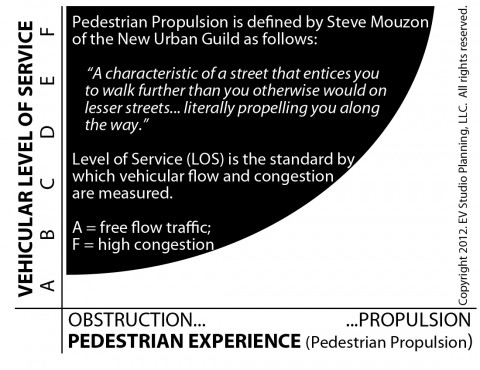Discussions of one-way streets are commonplace in planning circles in the United States. They usually arise with the best of intentions for a community as transportation planning usually does. See Strong Towns Blog Post: Paved with Good Intentions for more information. In some instances, they are intended to allow for something that may otherwise seem unfeasible, such as bike lanes. The issue with good intentions usually comes with an inverse relationship to another. The diagram below is the inverse relationship between Transportation Planning’s Level of Service and the Pedestrian Experience, or as defined by Steve Mouzon, Pedestrian Propulsion.

Before the transportation planners and engineers come after me on this one, I realize that there are exceptions to the inverse relationship. There always are exceptions, right? Most often, our transportation planning occurs in a silo that does not consider the oldest, most sustainable and fundamental aspect of transportation – walking. I said most often, because I do know some very good transportation planners who take it all into account… you know who you are.
The point is that we cannot jeopardize one form of transportation in favor of another. Believe it or not, there are negative consequences when we flip the scenario and only favor the pedestrian with disregard to the vessels that pedestrians are dependent upon. The incredible failures of pedestrian malls across the United States are a perfect example.
One instance that was recent in the Colorado Springs Metropolitan Area was the implementation of two adjacent two-way streets with center turn lanes into one-way streets with bike lanes. As I mentioned, the intentions were good for greater bicycle infrastructure. However, the results were predictable: 1) increased vehicular travel speeds; 2) decreased connectivity; and 3) occasional confusion and frustration (by me in particular).
In modifying three lanes of vehicular lanes into two lanes with a 6-foot bicycle lane, the vehicular travel lanes were increased in width with less visual obstacles (oncoming traffic). This combination increased the speed of the street. I should state this with the caveat that the posted speed limit did not increase, but the character of the street gives visual cues of how fast we should drive on them (See the UConn Survey and Strong Towns Blog Post: Name that Speed).
This past week, I spoke with a small mountain town in Southern Colorado about potential strategies that they could apply. The discussion of one way streets was discussed and it was evident that prior debate had occurred on the subject. I proceeded with caution on the topic with an initial statement of bias that the result of a retrofit to a one-way street is often expensive and counter-productive for a town or city. Perhaps it wasn’t too cautious, but the audience responded in agreement. As I mentioned in the discussion, there are occasions when one way streets are productive such as a substitution for an urban highway; referencing Peter Calthorpe’s One-Way Couplet.
The takeaway from the discussion is something I stated earlier, but it is worth repeating: The point is that we cannot jeopardize one form of transportation in favor of another. There is a balance that needs to occur for the viability of a place.






